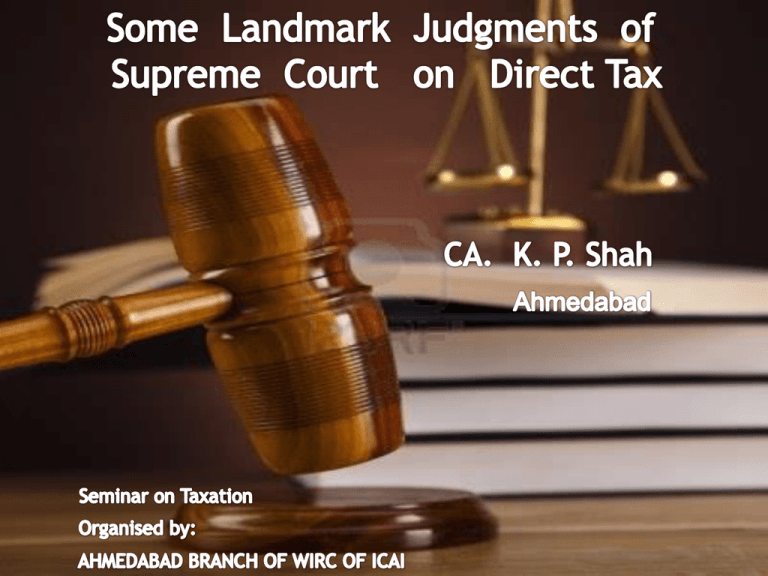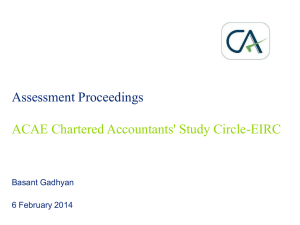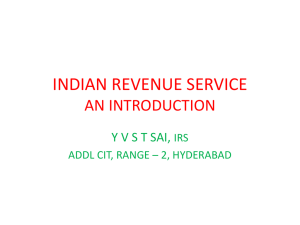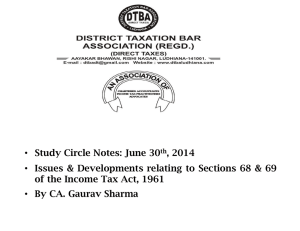Some Landmark Judgments of Supreme Court on Direct Taxes
advertisement

K.P.Shah Associates - Chartered Accountants 1 Binding force of a Supreme Court Judgment: The following propositions are well-settled with regard to the binding nature of a judgment of the Supreme Court: Under art 141 of the Constitution, ‘The law declared by the Supreme Court shall be binding on all courts within the territory of India’. Once there is a pronouncement of the highest Court of the land, the same is binding on all courts, tribunals and all authorities in view of this article [CIT v. Vallabhdas 253 ITR 543 (Guj.)]. If the Supreme Court has construed the meaning of a section, then any decision to the contrary given by any other authority must be held to be erroneous and such error must be treated as an error apparent on the record. Needless to say, a judgment of Supreme Court is binding on all High Courts. But it is the principle laid down in the judgment, and not every word appearing therein, that becomes the law of the land. Further, art 141 will not be attracted if law is not declared or stated vocally to support the conclusion reached for deciding the lis; because a conclusion may be on facts – it may not and does not necessarily involve consideration of law. K.P.Shah Associates - Chartered Accountants 2 When the Supreme Court declares the law and holds either a particular levy to be valid or invalid, the law laid down by the Supreme Court in that judgment would bind not only those parties who were before the court but also others in respect of whom appeal had not been filed [ U.P Pollution Control Board v. Kanoria Ind. Ltd. 259 ITR 321 (SC)]. In case of conflict between the decisions of the Supreme Court, the decision of the larger bench should be followed. Between two decisions of benches of equal strength of the Supreme Court, the later decision should be followed, provided the earlier decision is considered. K.P.Shah Associates - Chartered Accountants 3 Acceptance or Rejection of Petition for Special Leave to Appeal: The Supreme Court elaborately dealt with the effect of acceptance or rejection of a special leave petition in Kunhayammed v. State of Kerala, (245 ITR 360) and has held that when there is a refusal of special leave to appeal in non speaking order, i.e., an order that does not assign reasons for the dismissal of the special leave petition, it does not amount to a declaration of the law as laid down by the Supreme Court, since there is no law that has been declared. On the other hand, if the refusal is in the form of a speaking order, it then becomes a declaration of law within the meaning of art 141 of the Constitution binding not only on the parties but also on all judicial fora in the country. In either case, the doctrine of merger, which would effectuate the merger of the decision of the lower court with the Supreme Court order, is not attracted. But once special leave to appeal from an order has been granted by the Supreme Court, the order passed thereafter by the Supreme Court would be an appellate order and would then attract the doctrine of merger; whether the order reverses, modifies or affirms the decision of the lower court, and whether it is a speaking or non-speaking order. K.P.Shah Associates - Chartered Accountants 4 Thus, the mere fact that the Supreme Court refuses to grant special leave to appeal against a judgment does not necessarily imply that it accepts that judgment as correct, though in the circumstances of a case such an inference may be permissible. Conversely, the mere filing of a special leave petition or grant of leave to appeal or pendency of appeal against the High Court’s judgment does not denude that judgment of its binding effect. (Kanga, Palkhivala and Vyas – VOL.1, Ninth Edition Page:36-3738) K.P.Shah Associates - Chartered Accountants 5 Reliance on Decisions: A precedent is an authority only for what it actually decides and not for what may remotely or even logically follow from it; and a decision on a question that has not been argued cannot be treated as a precedent. Judgments must be read as whole and observations in judgments should be considered in the context in which they are made and in the light of questions that were before the court. In CIT v. Sun Engineering Works Pvt. Ltd. (198 ITR 297) the Supreme Court observed: It is neither desirable nor permissible to pick out a word or a sentence from the judgment of the Supreme Court divorced from the context of the question under consideration and treat it to be the complete law declared by the court. The judgment must be read as a whole and the observations from the judgment have to be considered in the light of the questions which were before the court. A decision of the Supreme Court takes its colour from the questions involved in the case in which it is rendered and, while applying the decision to a later case, courts must carefully try to ascertain the true principle laid down by the decision. K.P.Shah Associates - Chartered Accountants 6 Ratio Decidendi, Obiter Dicta, and Casual Observations: Two questions may arise before the court for its determination. The court may determine both, although only one of them may be necessary for the ultimate decision of the case. The question which was necessary for determination of the case would be the ratio; the opinion of the court on the question which was not necessary to decide the case would be only obiter dictum. The difference between obiter dictum and ‘casual observations’ of the Supreme court is that casual observation are made on points which do not arise for the determination of the court at all. Thus, it would be incorrect to say that every opinion of the Supreme Court would be binding upon the High Court in India; the only opinion which would be binding would be an opinion expressed on a question that arose for the determination of the Supreme Court, even though ultimately it might be found that the particular question was not necessary for the decision of the case. The obiter dicta of the Supreme Court should be followed by the High Courts; but where they are in conflict with the ratio of the same or another decision of the Supreme Court, the ratio should be followed in preference to the obiter dicta. (on page:42) K.P.Shah Associates - Chartered Accountants 7 Badridas Daga v. CIT 34 ITR 10 (SC) “Profits and gains which are liable to be taxed u/s.10(1) of the 1922 Act [corresponding to sec.28 of the 1961 Act], are what are understood to be such under ordinary commercial principles. When claim is made for a deduction for which there is no specific provision in Act, whether it is admissible or not will depend on whether, having regard to accepted commercial practice and trading principles, it can be said to arise out of the carrying of the business and to be incidental to it. If that is established, then the deduction must be allowed, provided of course there is no prohibition against it, express or implied, in the Act.” CIT v. S. C. Kothari 82 ITR 794 (SC) "If a business is illegal, neither the profits earned nor the losses incurred would be enforceable in law: but that does not take the profits out of the taxing statute. Similarly, the taint of illegality of the business cannot detract from the losses being taken into account for computation of the amounts which can subjected to tax under section 10(1). The tax collector cannot be heard to say that he will bring the gross receipts to tax, he can only tax profits of a trade or business. That cannot be done without deducting losses and the legitimate expenses of the business.“ CIT v. Piara Singh [ 124 ITR 40 (SC) ] K.P.Shah Associates - Chartered Accountants 8 Dr. T. A. Quereshi v. CIT 157 Taxman 514 (SC) “The Explanation to Sec.37 has really nothing to do with the present case as it is not a case of business expenditure, but of business loss. Business losses are allowable on ordinary commercial principles in computing profits. Once it is found that the heroin seized formed part of the stock-in-trade of assessee, it follows that the seizure and confiscation of such stock -in-trade has to be allowed as a business loss. Loss of stock-in-trade has to be considered as a trading loss. Vide CIT v. S.N.A.S.A. Annamalai Chettiar AIR 1973 SC 1032.” K.P.Shah Associates - Chartered Accountants 9 CIT v. SMIFS Securities Ltd. 348 ITR 302 (SC) Held that goodwill is an asset within the meaning of section 32 and depreciation on 'goodwill' is allowable under the said section. Techno Shares & Stocks Ltd. v. CIT 327 ITR 323 (SC) The right of membership, conferred upon a member under BSE membership card in terms of rules and bye-laws of BSE, which includes right of nomination, is a ‘licence’ or ‘akin to a licence’ which is one of the items which falls in section 32(1)(ii). The right to participate in the market has an economic and monetary value. It is an expense incurred by the assessee which satisfies the test of being a ‘licence’ or “any other business or commercial right of similar nature” in terms of section 32(1)(ii). K.P.Shah Associates - Chartered Accountants 10 Mysore Minerals Ltd. v. CIT 239 ITR 775 (SC) The term ‘owned’ as occurring in section 32(1) must be assigned a wider meaning. Any one in possession of property in his own title exercising such dominion over the property as would enable others being excluded therefrom and having right to use and occupy the property and/or to enjoy its usufruct in his own right would be the owner of the buildings though a formal deed of title may not have been executed and registered as contemplated by the Transfer of Property Act, 1882, Registration Act, etc. ‘Building owned by the assessee’ - the expression as occurring in section 32(1) - means the person who having acquired possession over the building in his own right uses the same for the purposes of the business or profession though a legal title has not been conveyed to him consistently with the requirements of laws such as Transfer of Property Act and Registration Act, etc., but nevertheless is entitled to hold the property to the exclusion of all others. Refer: CIT v. Podar Cement (P.) Ltd. 226 ITR 625 (SC) K.P.Shah Associates - Chartered Accountants 11 S. A. Builders Ltd. v. CIT 158 Taxman 74 (sc) It is not in every case that interest on borrowed loan has to be allowed if the assessee advances it to a sister concern. It all depends on the facts and circumstances of the respective case. For instance, if the directors of the sister concern utilize the amount advanced to it by the assessee for their personal benefit, obviously it cannot be said that such money was advanced as a measure of commercial expediency. However, money can be said to be advanced to a sister concern for commercial expediency in many other circumstances. Where holding company, has a deep interest in its subsidiary, and the holding company advances borrowed money to a subsidiary without interest and the same is used by the subsidiary for some business purposes, the holding company would ordinarily be entitled to deduction of interest on its borrowed loans. ACIT v. Tulip Star Hotel Ltd. 21 Taxmann.com 97 (SC) Hon’ble Supreme Court held “In our view, S.A. Builders Ltd. v. Commissioner of Income-Tax (Appeals) and Another, reported in 288 ITR 1, needs reconsideration.” K.P.Shah Associates - Chartered Accountants 12 CIT v. Core Health Care Ltd. 298 ITR 194 (SC) Section 36(1)(iii) of the 1961 Act has to be read on its own terms. It is a Code by itself. Section 36(1)(iii) is attracted when the assessee borrows the capital for the purpose of his business. It does not matter whether the capital is borrowed in order to acquire a revenue asset or a capital asset, because of that the section requires is that the assessee must borrow the capital for the purpose of his business. This dichotomy between the borrowing of a loan and actual application thereof in the purchase of a capital asset, seems to proceed on the basis that a mere transaction of borrowing does not, by itself bring any new asset of enduring nature into existence, and that it is the transaction of investment of the borrowed capital in the purchase of a new asset which brings that asset into existence. The transaction of borrowing is not the same as the transaction of investment. If this dichotomy is kept in mind it becomes clear that the transaction of borrowing attracts the provisions of section 36(1)(iii). Vardhman Polytex Ltd. V. CIT [210 Taxman 261 (SC)] Hon’ble Supreme Court followed the decision of CIT v. Core Health Care Ltd. (Supra). K.P.Shah Associates - Chartered Accountants 13 T. R. F. Ltd. v. CIT 323 ITR 397 (SC) Vijaya Bank v. CIT 323 ITR 166 (SC) “As regards to Sec 36(1)(vii) the law is well settled. After 01/04/1989, it is not necessary for the assessee to establish that the debt, in fact, has become irrecoverable. It is enough if the bad debt is written off as irrecoverable in the accounts of the assessee.” It is not imperative for assessee-bank to close individual account of each of its debtors in its books; a mere reduction in loans and advances or debtors on asset side of its balance sheet to the extent of provision for bad debt would be sufficient to constitute write off. Southern Technologies Ltd. v. Jt. CIT 187 Taxman 346 (SC) “The nature of expenditure under the IT Act can not be conclusively determined by the manner in which accounts are presented in terms of RBI Directions 1998. In our view, RBI Directions 1998, though deviate from accounting practice as provided in the Companies Act, do not over ride the provisions of the IT Act. RBI Directions 1998 and the IT Act operate in different fields.” K.P.Shah Associates - Chartered Accountants 14 Southern Technologies Ltd. v. Jt. CIT 187 Taxman 346 (SC) Section 37 applies only to items which do not fall in Sections 30 to 36; if a provision for doubtful debt is expressly excluded from section 36(1)(vii), then such provision can not be claimed as a deduction u/s 37 even on the basis of ‘real income theory.’ CIT v. Dhanrajgirji Raja 91 ITR 544 (SC) It is not open to the department to prescribe what expenditure assessee should incur and in what circumstances he should incur that expenditure. Every businessman knows his interest best. Sassoon J. David & Co. (P.) Ltd. v. CIT 118 ITR 261 (SC) The expression ‘wholly and exclusively’ used in section 10(2)(xv) of the 1922 Act [corresponding to Sec 37(1) of the 1961 Act] does not mean necessarily. The fact that somebody other than the assessee is also benefited by the expenditure should not come in the way of an expenditure being allowed by way of deduction if it satisfies otherwise the tests laid down by law. K.P.Shah Associates - Chartered Accountants 15 CIT v. Woodward Governor India (P.) Ltd. 312 ITR 254 (SC) Section 37(1), read with section 145, of the Income-tax Act, 1961 Business expenditure - Allowability of - Assessment year 1998-99 Whether expression ‘expenditure’ as used in section 37 may, in circumstances of a particular case, cover an amount which is really a ‘loss’, even though said amount has not gone out from pocket of assessee - Held, yes Whether loss suffered by assessee on account of foreign exchange difference as on date of balance sheet is an item of expenditure under section 37(1) - Held, yes Whether an enterprise has to report outstanding liability relating to import of raw material using closing rate of foreign exchange and any difference, loss or gain, arising on conversion of said liability at closing rate should be recognized in profit and loss account for reporting period - Held, yes II. Section 43A of the Income-tax Act, 1961 - Foreign currency, rate of exchange, change in - Assessment year 1998-99 - Whether amendment to section 43A by Finance Act, 2002 w.e.f 1-4-2003 is amendatory and not clarificatory - Held, yes Whether under unamended section 43A, ‘actual payment’ was not a condition precedent for making necessary adjustment in carrying cost of fixed asset acquired in foreign currency - Held, yes K.P.Shah Associates - Chartered Accountants 16 Whether therefore, prior to amendment to section 43A, assessee was entitled to adjust actual cost of imported assets acquired in foreign currency on account of fluctuation in rate of exchange at each balance-sheet date, pending actual payment of varied liability - Held, yes Bharat Earth Movers v. CIT 245 ITR 428 (SC) The law is settled: if a business liability has definitely arisen in the accounting year, the deduction should be allowed although the liability may have to be quantified and discharged at a future date. What should be certain is the incurring of the liability. It should also be capable of being estimated with reasonable certainty though the actual quantification may not be possible. If these requirements are satisfied, the liability is not a contingent one. The liability is in praesenti though it will be discharged at a future date. It does not make any difference if the future date on which the liability shall have to be discharged is not certain. K.P.Shah Associates - Chartered Accountants 17 India Cements Ltd. V. CIT 60 ITR 52 (SC) A loan obtained can not be treated as an asset or advantage for the enduring benefit of the business of the assessee. A loan is a liability and has to be repaid and, it is erroneous to consider a liability as an asset or an advantage. The nature of the expenditure incurred in raising a loan would not depend upon the nature of purpose of the loan. A loan may be intended to be used for the purchase of raw material when it is negotiated, but the company may, after raising the loan, change its mind and spend it on securing capital assets. Therefore, the purpose for which the new loan was required was irrelevant to the consideration of the question whether the expenditure for obtaining the loan was the revenue expenditure or capital expenditure. K.P.Shah Associates - Chartered Accountants 18 CIT v. Woodward Governor India (P.) Ltd. 312 ITR 254 (SC) E.D. Sassoon & Co. Ltd. v. CIT 26 ITR 27 (SC) SC Held “ under the mercantile system of accounting, what is due is brought into credit before it is actually received; it brings into debit an expenditure for which a legal liability has been incurred before it is actually disbursed.” Right to receive coupled with obligation to Pay. “Unless and until there is created in favour of the assessee a debt done by somebody it can not be said that he has acquired a right to receive the income or that income has accrued to him.” CIT v. Shoorji Vallabhdas & Co. 46 ITR 144 (SC) Godhra Electricity Co. Ltd. v. CIT 225 ITR 746 (SC) In this case Hon’ble Supreme Court has followed its earlier decision of Soorji Vallabhdas & Co. (supra) and held as follows:- “Income tax is a levy on income. No doubt, the Income tax Act takes into account two points of time at which the liability to tax is attracted, viz., the accrual of the income or its receipts; but the substance of the matter is the income. If income does not result at all, there can not be a tax, even though in book-keeping, an entry is made about a hypothetical income, which does not materialize.” K.P.Shah Associates - Chartered Accountants 19 Sanjeev Woolen Mills v. CIT [ 279 ITR 434 (SC)] “What is material for the purpose of Sec.145 of the I.T Act,1961, is, the method should be such that the real income, profits and gains can be properly deduced therefrom. If the method adopted does not afford a true picture of the profits, it would be rejected, but such rejection should be based on cogent evidence and would be done with caution. The power can be exercised by the A.O to choose the basis and manner of computation of income but he must exercise his discretion and judgment judicially and reasonably.” CIT v. British Paints India Ltd. [188 ITR 44 (SC)] Even if the assessee had adopted a regular system of accounting, it was the duty of the Assessing officer u/s 145 of the Income Tax Act, 1961, to consider whether the correct profits and gains could be deduced from the accounts so maintained. If he was of the opinion that the correct profits could not be deduced from the accounts, he was obliged to have recourse to the proviso to section 145 of the Income Tax Act, 1961. There is no estoppel in these matters, and the officer is not bound by the method followed in the earlier years. K.P.Shah Associates - Chartered Accountants 20 CIT v. Woodward Governor India (P.) Ltd. 312 ITR 254 (SC) SC Held “The accounting method followed by an assessee continuously for a given period of time has to be presumed to be correct till the AO comes to the conclusion for reasons to be given that the system does not reflect true and correct profit.” UCO Bank v. CIT 237 ITR 889 (SC) The method of accounting which is followed by the assessee-bank is mercantile system of accounting. However, the assessee considers income by way of interest pertaining to doubtful loans as not real income in the year in which it accrues, but only when it is realized. A mixed method of accounting is thus followed by the assessee-bank. This method of accounting adopted by the assessee is in accordance with accounting practice. Kachwala Gems v. JCIT 288 ITR 10 (SC) SC held “Books are rightly rejected u/s 145(3). It was the assessee himself who was to blame as he did not maintain proper books. K.P.Shah Associates - Chartered Accountants 21 CIT v. Woodward Governor India (P.) Ltd. [312 ITR 254 (SC)] Under Sec.28(i), one needs to decide the profits and gains of the business. Therefore one has to take into account stock in trade for determination of profits. The 1961 Act makes no provision with regard to valuation of stock but the ordinary principle of commercial accounting requires that in the P&L A/c the value of the stock in trade at the beginning and at the end of the year should be entered at cost or market price, whichever is the lower. This is how the business profits arising during the year need to be computed. While anticipated loss is taken into account, anticipated profit in the shape of anticipated value of the closing stock is not brought into account. (on page: 263) Sanjeev Woolen Mills v. CIT [279 ITR 434 (SC)] The market value of the stock has been taken into consideration while arriving at chargeable income although the market value of the stock is more than the cost value of the stock. The profit earned is only notional. There is no transfer of the goods and the closing stock remains the opening stock of the next accounting year. The income which has not been derived at by the assessee cannot be said to be the income chargeable for income and, therefore, the rejection of the accounts maintained by the assessee for the valuation of the closing stock by the Assessing Officer and confirmed by the High Court is in accordance with law. K.P.Shah Associates - Chartered Accountants 22 Chainrup Sampatram v. CIT [24 ITR 481 (SC)] A. L. A. Firm v. CIT [189 ITR 285 (SC)] In order to arrive at the correct picture of the trading result of the partnership on the date when it ceases to function, the valuation of the stock in hand should be made on the basis of the prevailing market price. Sakthi Trading Co. V. CIT [250 ITR 871 (SC)] “Valuation of closing stock at cost or at market value whichever is less is a generally accepted and established rule of commercial practice.” Where on the dissolution of the firm the business is taken over by a partner without discontinuance and the value of the closing stock determined under the regular method of accounting is accepted by the partners in the settlement of accounts for dissolution purposes, the ITO cannot substitute the market value in respect of the closing stock alone for the purpose of determining the income of the firm up to the date of dissolution. CIT v. Ahmedabad New Cotton Mills Co. Ltd. [4 ITC 245 (PC)] Where both opening and closing stock are under valued, both should be altered. K.P.Shah Associates - Chartered Accountants 23 Tirunelveli Motor Bus Service Co. (P.) Ltd. v. CIT [78 ITR 55 (SC)] Unless it is proved that an allowance or deduction has been made in the assessment in any previous year in respect of loss, expenditure or trading liability, it is not open to the revenue to refer to section 41(1) for charging the tax on the receipt by the assessee by refund or otherwise of such expenditure in a subsequent year. Polyflex (India) (P.) Ltd. v. CIT [257 ITR 343 (SC)] In the instant case, it was the first clause that squarely applied but not the second one. Whether there was cessation or remission of liability was an irrelevant line of enquiry. The correct way of understanding section 41(1) is to read with latter clause - ‘some benefit in respect of such trading liability by way of remission or cessation thereof’ as a distinct and self-contained provision. To read the phrases ‘by way of remission or cessation thereof; as governing the previous clause as well, i.e. ‘obtained any amount in respect of such loss or expenditure’, would be doing violence to the language and structure of the provision. That apart, the operation of the provision which is designed to have widest amplitude will get constricted and truncated by reason of such interpretation. (On page 350) K.P.Shah Associates - Chartered Accountants 24 CIT v. Tirumalaiswamy Naidu & Sons. [230 ITR 534 (SC)] The sales tax collected by the assessee had to be treated as its income. Any payment of sales tax made by the assessee was equally liable to be deducted from the profits made by the assessee. If any deduction was given from that income and later the same was refunded back to the assessee, the refund would have the character of revenue receipt. It had to be treated as a receipt on the revenue account and had to be assessed as such. The amount of sales tax refunded would be liable to tax under express provision of section 41(1). The assessee, however, would be entitled to claim deduction of sales tax refunded when such refund was made to customers. Bombay Dyeing and Mfg. Co. Ltd. [AIR 1958 SC 328] “When a debt becomes time barred it does not become extinguished but is only unenforceable in court of law.” K.P.Shah Associates - Chartered Accountants 25 CIT v. T. V. Sundaram Iyengar & Sons Ltd. 222 ITR 344 (SC) In the present case, the money was received by the assessee in course of carrying on his business. Although it was treated as deposit and was of capital nature at the point of time it was received, by influx of time the money has become the assessee's own money. What remains after adjustment of the deposits has not been claimed by the customers. The claims of the customers have become barred by limitation. The assessee itself has treated the money as its own money and taken the amount to its profit and loss account. There is no explanation from the assessee why the surplus money was taken to its profit and loss account even if it was somebody else's money. In fact, as Atkinson, J. pointed out that what the assessee did was the commonsense way of dealing with the amounts. K.P.Shah Associates - Chartered Accountants 26 Kale khan Mohammad Hanif v. CIT 50 ITR 1 (SC) "Whether the burden of proving the source of the cash credits is on the assessee ?" It seems to us that the answer to this question must be in the affirmative and that is how it was answered by the High Court. It is well established that the onus of proving the source of a sum of money found to have been received by the assessee is on him. If he disputes liability for tax, it is for him to show either that the receipt was not income or that if it was, it was exempt from taxation under the provisions of the Act. In the absence of such proof, the Income-tax Officer is entitled to treat it as taxable income. Shreelekha Benerjee v. CIT 49 ITR 112 (SC) Before the department rejects such evidence, it must either show an inherent weakness in the explanation or rebut it by putting to the assessee some information or evidence which it has in its possession. The department cannot by merely rejecting unreasonably a good explanation, convert good proof into no proof. It is within the range of these principles that such cases have to be decided. K.P.Shah Associates - Chartered Accountants 27 CIT v. K.S. Kannan Kunhi 87 ITR 395 (SC) Roshan Di Hatti v. CIT 107 ITR 938 (SC) A.O must examine the merits of assessee’s explanation for Cash Credit in the books. No addition can be made by merely observing that the explanation is not satisfactory. “The impossibility of the assessee having earned such a huge amount of profit within a few months immediately after migration to India in the disturbed and unsettled conditions which then prevailed must, therefore, necessarily support the inference that the assessee must have brought these assets from Lahore.” CIT v. Durga Prasad More 82 ITR 540 (SC) “The law does not prescribe any quantitative test to find out whether the onus in a particular case has been discharged or not. It all depends on the facts and circumstances of each, case. In some cases, the onus may be heavy whereas, in others, it may be nominal. There is nothing rigid about it.” K.P.Shah Associates - Chartered Accountants 28 CIT v. Orissa Corporation Pvt. Ltd. 159 ITR 78 (SC) “In this case the assessee had given the names and addresses of the alleged creditors. It was in the knowledge of the revenue that the said creditors were the income-tax assessees. Their index number was in the file of the revenue. The revenue, apart from issuing notices under section 131 at the instance of the assessee, did not pursue the matter further. The revenue did not examine the source of income of the said alleged creditors to find out whether they were credit-worthy or were such who could advance the alleged loans. There was no effort made to pursue the so-called alleged creditors. In those circumstances, the assessee could not do any further. In the premises, if the Tribunal came to the conclusion that the assessee has discharged the burden that lay on him then it could not be said that such a conclusion was unreasonable or perverse or based on no evidence. If the conclusion is based on some evidence on which a conclusion could be arrived at, no question of law as such arises.” CIT v. Daulat Ram Rawatmull 87 ITR 349 (SC) “The onus to prove that the apparent is not the real is on the party who claims it to be so.” K.P.Shah Associates - Chartered Accountants 29 Sumati Dayal v. CIT 214 ITR 801 (SC) “There is no dispute that the amounts were received by the appellant from various race clubs on the basis of winning tickets presented by her. What is disputed is that they were really the winnings of the appellant from the races. This raises the question whether the apparent can be considered as real. As laid down by this Court, apparent must be considered real until it is shown that there are reasons to believe that the apparent is not the real and that the taxing authorities are entitled to look into the surrounding circumstances to find out the reality and the matter has to be considered by applying the test of human probabilities. CIT v. Durga Prasad More [1971] 82 ITR 540, at pp. 545, 547 (SC).” CIT v. P. Mohanakala 291 ITR 278 (SC) NRI gifts – addition confirmed by Hon’ble Supreme Court by following decision of Sumati Dayal v. CIT (supra). K.P.Shah Associates - Chartered Accountants 30 CIT v. Smt. P. K. Noorjahan 237 ITR 570 (SC) “This clearly indicates that the intention of the Parliament in enacting section 69 was to confer a discretion on the ITO in the matter of treating the source of investment which has not been satisfactorily explained by the assessee as the income of the assessee and the ITO is not obliged to treat such source of investment as income in every case where the explanation offered by the assessee is found to be not satisfactory.” Chuharmal v. CIT 172 ITR 250 (SC) “Section 110 of the Evidence Act is material in this respect and the High Court relied on the same which stipulates that when the question is whether any person is owner of anything of which he is shown to be in possession, the onus of proving that he is not the owner, is on the person who affirms that he is not the owner. In other words, it follows from the well-settled principle of law that normally, unless contrary is established, title always follows possession.” K.P.Shah Associates - Chartered Accountants 31 CIT v. Walfort Share & Stock Brokers (P.) Ltd.[326 ITR 1 (SC)] Sec.14A of the I.T Act, 1961 - Income - Expenditure incurred in relation to income not includible in total income – A.Y 2000-01 Whether words ‘expenditure incurred’ in section 14A refers to expenditure on rent, taxes, salaries, interest, etc., in respect of which allowances are provided for under sec. 30 to 37; a return of investment or a pay back is not ‘expenditure incurred’ in terms of section 14A - Held, yes - Whether for attracting section 14A, there has to be a proximate cause for disallowance, which is its relationship with tax exempt income and since pay-back or return of investment is not such proximate cause, section 14A is not applicable in such cases - Held, yes Section 94 of the I.T Act, 1961 - Avoidance of tax by certain transactions in securities - Whether by inserting section 94(7) with effect from 1-4-2002, Parliament has not treated dividend stripping transactions as sham or bogus - Held, yes - Whether by applying section 94(7) in a case for A.Y falling after 1-4-2002, loss to be ignored would be only to extent of dividend received and not entire loss and, thus, losses over and above amount of dividend received would still be allowed - Held, yes K.P.Shah Associates - Chartered Accountants 32 Kishanchand Chellaram v. CIT 125 ITR 713 (SC) The Hon’ble Supreme Court after considering all the facts and circumstances observed that though the proceedings under Income Tax Law are not governed by the strict rules of evidence, the Department is bound to afford an opportunity to controvert and cross examine the evidence on which the department places its reliance. Income-tax Officer v. M. Pirai Choodi 334 ITR 262 (SC) Section 143 of the Income-tax Act, 1961 - Assessment - General – A.Y. 2004-05 - Order of assessment passed without granting an opportunity to assessee to cross-examine, should not have been set aside by High Court; at most, High Court should have directed Assessing Officer to grant an opportunity to assessee to crossexamine concerned witness [In favour of revenue]. K.P.Shah Associates - Chartered Accountants 33 Mehta Parikh & Co. v. CIT 30 ITR 181 (SC) “Affidavits filed but contents have not been disproved by cross examining the deponent it would not be open to Revenue to disregard the averments made in the affidavit.” [Glass Lines Equipments Co. Ltd. V. CIT 253 ITR 454 (Guj.) ] K.P.Shah Associates - Chartered Accountants 34 Navnitlal C. Javeri v. K.K.Sen, Appellate Assistant 56 ITR 198 (SC) UCO Bank v. CIT 237 ITR 889 (SC) “CBDT has power, inter alia, to issue circulars to tone down the rigour of the law and ensure fair enforcements of its provisions; so long as such a circular is in force it would be binding on the Departmental authorities in view of the provisions of Sec.119 to ensure a uniform and proper administration and application of the I.T Act.” K.P.Shah Associates - Chartered Accountants 35 36








